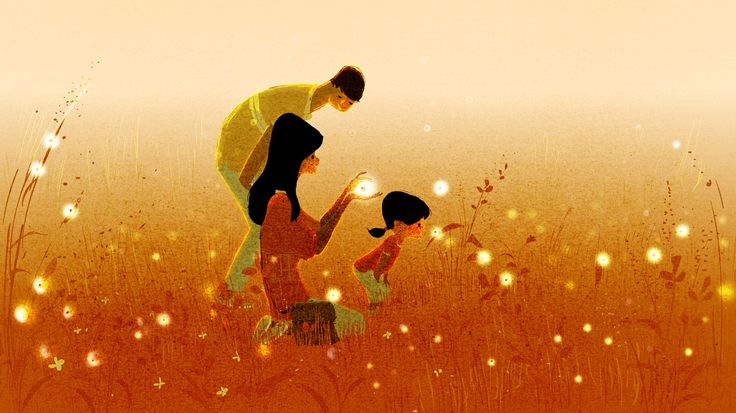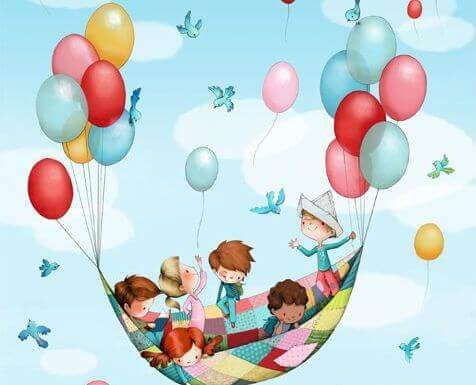The Montessori Method of Education: Joyful Learning


Written and verified by the psychologist Valeria Sabater
The world, seen through the eyes of a child, opens like a window and they encounter multiple sensations, colors, sounds, and spectacular concepts to interpret and understand. The best way to integrate each of these experiences in our children’s brains is through love, affection, and joy. These are the elements that the famous educator, María Montessori, noted.
Children need our guidance and support to make their way through the complex network of the world. However, they also need the confidence to be themselves, to be the architects of their own learning.
María Montessori gave us an interesting educational legacy from which we learned how to educate happy children. She claimed that we must plant noble ideas in the minds of our children so that tomorrow they’ll germinate in their hearts and allow them to grow, joyfully.
María Montessori and her method of teaching
You’ve probably heard about María Montessori. She was a famous Italian educator and philosopher. In fact, she founded the world-renowned Montessori method of education. In her era, the humble Europe of the early twentieth century, many of her principles were seen as a real revolution in the educational field.
Her essential idea was to achieve an integral development of the child through continuous stimulation of their senses, emotions, and experiences. In fact, the student is always an active agent in their “spontaneous” discoveries that they achieve due to having autonomy and freedom.
Obviously, the concept of “freedom” was associated with adult supervision and guidance. Nevertheless, the idea of this “active school” with its principles and structures, led people to apply the same concepts when educating their children in the home.
Indeed, you can develop the Maria Montessori method of education yourself in your day-to-day life with your children. You can educate them in joy, happiness, and freedom… Let’s take a closer look.
Educate in freedom, educate in love

Between 0 and 11 years is when children possess their greatest potential. In fact, the most intense period is between 0 and six years. This is what María Montessori classified as sensitive periods. In other words, moments of great plasticity of the brain in the neuro-emotional development of the little ones.
Each discovery in a child is a personal achievement. Indeed, there’s no greater happiness for them than feeling safe and happy in joyfully moving forward on the path of daily learning, where we offer our love to them.
However, one element of this method that’s sometimes viewed with some trepidation is the idea of “giving freedom” to children. We need to qualify this idea. Therefore, in this article, we delve a little deeper into the María Montessori method of education in order to understand it a little more. We also explain the indisputable value of educating with emotion. In fact, with joy.
Maria Montessori strategy: teaching children to do it themselves
Giving our children freedom doesn’t mean giving them complete autonomy. In order to understand it a little better, here are the guidelines of the Montessori method.
- For children to be able to acquire and establish learning, they initially need a guide. Later, they’re able to do it for themselves.
- If we solve their tasks and carry out their daily obligations for them, or set limits in their day-to-day routine to keep them under control, children won’t be able to discover things on their own. Furthermore, we’ll generate dependency or anxiety in them in the face of our need for continuous “supervision.”
- We should offer them support on a day-to-day basis and show them that they’re capable of many things, Furthermore, we must show them that we love them. The feeling of knowing that they’re loved and recognized will give them the security to move forward.
The positive reinforcement of educating in joy and not in threats
“You do everything wrong because you just don’t listen!”, “Your brother’s so much smarter than you”, “You’re never going to pass.”… These kinds of expressions are absolutely devastating for any child. Negative verbalizations aren’t educational. In addition, they don’t help and they generate low self-esteem as well as anger.
- We should avoid these kinds of admonitions at all costs. Because words and language can be extremely dangerous at times, particularly for a child. Remember, they always understand far more than we think.
- We should only use positive reinforcement in our ways of speaking. For example, saying things like “Okay, so the test went wrong, but I trust you and I know that you’re going to make a real effort next time.”
- Rather than fixating on our children’s mistakes, we should offer them guidance and strategies so they can figure things out on their own. Doing so will give them a boost of self-esteem and self-confidence.
- María Montessori always emphasized the need to respect the different stages at which children mature. We shouldn’t ever make them stressed. Neither should we ever compare them with their siblings or classmates.

The Maria Montessori strategy: discovering the world with joy
There’s is no better way for a child than joyfully making their way through life feeling confident, free, capable, and strong.
Therefore, to learn they must be motivated. This requires small daily efforts on our part, as parents. We should:
- Offer them numerous learning opportunities both at home and outside of it.
- Make our children active participants in the household chores. For example, we can let them help with the cooking, let them have their own plants to look after, let them choose their own books. In fact, we must allow them to have a voice and make sure they know how to listen to others.
- Offer challenges. Have a “surprise box” at home. In it, every day, we can introduce something new to our children. For instance, a story, a seed to plant, an invitation to go to a museum, a treat in exchange for a new responsibility…

Educating means being responsible, being creative, and making your child’s universe a legacy full of affection where he feels good, happy, and free to grow. Just as María Montessori recommended.
Images courtesy of Pascal Campion
The world, seen through the eyes of a child, opens like a window and they encounter multiple sensations, colors, sounds, and spectacular concepts to interpret and understand. The best way to integrate each of these experiences in our children’s brains is through love, affection, and joy. These are the elements that the famous educator, María Montessori, noted.
Children need our guidance and support to make their way through the complex network of the world. However, they also need the confidence to be themselves, to be the architects of their own learning.
María Montessori gave us an interesting educational legacy from which we learned how to educate happy children. She claimed that we must plant noble ideas in the minds of our children so that tomorrow they’ll germinate in their hearts and allow them to grow, joyfully.
María Montessori and her method of teaching
You’ve probably heard about María Montessori. She was a famous Italian educator and philosopher. In fact, she founded the world-renowned Montessori method of education. In her era, the humble Europe of the early twentieth century, many of her principles were seen as a real revolution in the educational field.
Her essential idea was to achieve an integral development of the child through continuous stimulation of their senses, emotions, and experiences. In fact, the student is always an active agent in their “spontaneous” discoveries that they achieve due to having autonomy and freedom.
Obviously, the concept of “freedom” was associated with adult supervision and guidance. Nevertheless, the idea of this “active school” with its principles and structures, led people to apply the same concepts when educating their children in the home.
Indeed, you can develop the Maria Montessori method of education yourself in your day-to-day life with your children. You can educate them in joy, happiness, and freedom… Let’s take a closer look.
Educate in freedom, educate in love

Between 0 and 11 years is when children possess their greatest potential. In fact, the most intense period is between 0 and six years. This is what María Montessori classified as sensitive periods. In other words, moments of great plasticity of the brain in the neuro-emotional development of the little ones.
Each discovery in a child is a personal achievement. Indeed, there’s no greater happiness for them than feeling safe and happy in joyfully moving forward on the path of daily learning, where we offer our love to them.
However, one element of this method that’s sometimes viewed with some trepidation is the idea of “giving freedom” to children. We need to qualify this idea. Therefore, in this article, we delve a little deeper into the María Montessori method of education in order to understand it a little more. We also explain the indisputable value of educating with emotion. In fact, with joy.
Maria Montessori strategy: teaching children to do it themselves
Giving our children freedom doesn’t mean giving them complete autonomy. In order to understand it a little better, here are the guidelines of the Montessori method.
- For children to be able to acquire and establish learning, they initially need a guide. Later, they’re able to do it for themselves.
- If we solve their tasks and carry out their daily obligations for them, or set limits in their day-to-day routine to keep them under control, children won’t be able to discover things on their own. Furthermore, we’ll generate dependency or anxiety in them in the face of our need for continuous “supervision.”
- We should offer them support on a day-to-day basis and show them that they’re capable of many things, Furthermore, we must show them that we love them. The feeling of knowing that they’re loved and recognized will give them the security to move forward.
The positive reinforcement of educating in joy and not in threats
“You do everything wrong because you just don’t listen!”, “Your brother’s so much smarter than you”, “You’re never going to pass.”… These kinds of expressions are absolutely devastating for any child. Negative verbalizations aren’t educational. In addition, they don’t help and they generate low self-esteem as well as anger.
- We should avoid these kinds of admonitions at all costs. Because words and language can be extremely dangerous at times, particularly for a child. Remember, they always understand far more than we think.
- We should only use positive reinforcement in our ways of speaking. For example, saying things like “Okay, so the test went wrong, but I trust you and I know that you’re going to make a real effort next time.”
- Rather than fixating on our children’s mistakes, we should offer them guidance and strategies so they can figure things out on their own. Doing so will give them a boost of self-esteem and self-confidence.
- María Montessori always emphasized the need to respect the different stages at which children mature. We shouldn’t ever make them stressed. Neither should we ever compare them with their siblings or classmates.

The Maria Montessori strategy: discovering the world with joy
There’s is no better way for a child than joyfully making their way through life feeling confident, free, capable, and strong.
Therefore, to learn they must be motivated. This requires small daily efforts on our part, as parents. We should:
- Offer them numerous learning opportunities both at home and outside of it.
- Make our children active participants in the household chores. For example, we can let them help with the cooking, let them have their own plants to look after, let them choose their own books. In fact, we must allow them to have a voice and make sure they know how to listen to others.
- Offer challenges. Have a “surprise box” at home. In it, every day, we can introduce something new to our children. For instance, a story, a seed to plant, an invitation to go to a museum, a treat in exchange for a new responsibility…

Educating means being responsible, being creative, and making your child’s universe a legacy full of affection where he feels good, happy, and free to grow. Just as María Montessori recommended.
Images courtesy of Pascal Campion
This text is provided for informational purposes only and does not replace consultation with a professional. If in doubt, consult your specialist.







